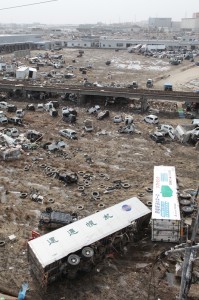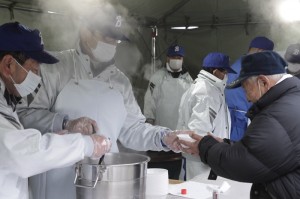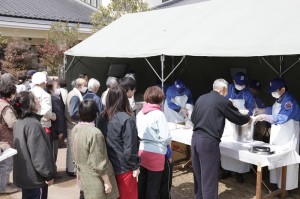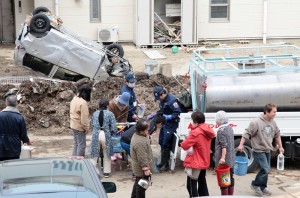 Even now—more than three weeks after the March 11 earthquake and tsunami wreaked havoc on northeastern Japan—some 160,000 people are still living in evacuation centers and shelters, most of which are in the three hardest-hit prefectures of Miyagi, Iwate, and Fukushima, where coastal towns were devastated by massive tsunami waves. Responding to calls for long-term relief and assistance, Tenrikyo Disaster Relief Headquarters has been planning and carrying out a variety of relief activities, one of which is to provide accommodation and meals for three thousand evacuees at followers dormitories and Church Headquarters facilities in Tenri.
Even now—more than three weeks after the March 11 earthquake and tsunami wreaked havoc on northeastern Japan—some 160,000 people are still living in evacuation centers and shelters, most of which are in the three hardest-hit prefectures of Miyagi, Iwate, and Fukushima, where coastal towns were devastated by massive tsunami waves. Responding to calls for long-term relief and assistance, Tenrikyo Disaster Relief Headquarters has been planning and carrying out a variety of relief activities, one of which is to provide accommodation and meals for three thousand evacuees at followers dormitories and Church Headquarters facilities in Tenri.
Tenrikyo Disaster Relief Headquarters has also been accepting donations to “Tenrikyo Disaster Relief Fund” and “Tenrikyo Fund to Support Affected Dioceses and Disaster Relief Hinokishin Corps.” As of April 5, “Tenrikyo Disaster Relief Fund” had received 2,100 donations totaling 139,238,685 yen (about US$1,643,000) and “Tenrikyo Fund to Support Affected Dioceses and Disaster Relief Hinokishin Corps” had received 1,249 donations totaling 113,744,810 yen (about US$1,342,000).
On April 6, the Shinbashira traveled to Iwate and Miyagi prefectures to pay visits to Tenrikyo churches affected by the disaster as well as to encourage followers who are involved in relief activities.
 As of April 6, Tenrikyo Disaster Relief Hinokishin Corps had sent corps from 22 dioceses into the affected areas. Those corps have established their base of operations in the cities of Tono and Ichinoseki in Iwate Prefecture and Higashimatsushima City in Miyagi Prefecture. In addition to distributing water and operating emergency kitchens as immediate relief measures, the corps members are also busy helping to remove wreckage and sludge as an initial step toward rebuilding the communities.
As of April 6, Tenrikyo Disaster Relief Hinokishin Corps had sent corps from 22 dioceses into the affected areas. Those corps have established their base of operations in the cities of Tono and Ichinoseki in Iwate Prefecture and Higashimatsushima City in Miyagi Prefecture. In addition to distributing water and operating emergency kitchens as immediate relief measures, the corps members are also busy helping to remove wreckage and sludge as an initial step toward rebuilding the communities.
Conducting relief activities in Iwate Prefecture: Iwate Diocese Disaster Relief Hinokishin Corps
The devastation in Iwate Prefecture is spread out over such a wide area that even now—over three weeks after the disaster—electricity, water, and gas have yet to be restored to many regions, and the coastal areas are still covered with mountains of wreckage and debris. In spite of these difficulties, Iwate Diocese’s disaster relief corps, headed by Corps Leader Shoji Otani, flew into action in the immediate aftermath of the catastrophe and has been proactively conducting relief activities in coordination with the local authorities.
Iwate Diocese Office quickly set about trying to ascertain the extent of damage to Tenrikyo churches within the diocese. Due to extensive damage from the earthquake and tsunami, however, roadblocks had been set up on the major roads, thus preventing them from entering the disaster areas. Obtaining emergency vehicle passes from the prefectural authorities on March 14, the diocese sent teams of its disaster relief corps to several hard-hit cities and towns, including Rikuzentakata, Ofunato, Kamaishi, Miyako, Otsuchi, and Yamada, on the 15th and 16th. After consulting with the prefectural authorities, the corps set up its base of operations at a public facility in Tono City, which has good transportation access to the coastal areas. It was also decided that the corps would begin relief operations requested by the local authorities on the 20th. The corps’s adviser explains: “Our disaster relief corps has sprung into action for every disaster in Iwate Prefecture, and we have also held training sessions in cities and towns throughout the prefecture. That earned us the prefectural government’s trust, which enabled us to get involved in relief activities with the government’s backing at an early stage of this crisis.”
While making preparations to begin relief operations, Corps Leader Otani received a phone call from an official in Kamaishi City, who requested that he and his members drive to Miyako City to pick up caskets for people who had lost their lives in the disaster. On the 16th and 17th, therefore, Iwate Diocese’s corps, together with the corps that had just arrived from Yamagata Diocese, made the four-hour drive to Miyako City, where they collected 70 ready-to-assemble caskets from a funeral home. After returning to Kamaishi City, the corps members assembled the caskets and carried them to the mortuary.
 On the 20th, Iwate Diocese’s corps began its official relief activities. On that day, the corps was asked by Kamaishi City’s authorities to help the Self Defense Force members, who were running an emergency kitchen in an evacuation center. The corps members also delivered meals to the houses of elderly people who were living alone.
On the 20th, Iwate Diocese’s corps began its official relief activities. On that day, the corps was asked by Kamaishi City’s authorities to help the Self Defense Force members, who were running an emergency kitchen in an evacuation center. The corps members also delivered meals to the houses of elderly people who were living alone.
From the 21st through the 24th, Iwate Diocese’s corps was joined by the corps from Akita Diocese. In addition to carrying out the duties they had been assigned in Kamaishi City, the members sorted relief goods that had arrived at a volunteer center in Tono City and took them to Kamaishi and Miyako cities, as well as the town of Otsuchi. They delivered these goods not only to evacuation centers but also to people in the neighborhood who were living in their own homes.
From the 25th, the disaster relief corps from Mie and Gunma dioceses joined in the relief activities in Iwate Prefecture. On that day, the corps members started full-scale recovery operations along Kamaishi City’s main shopping street, where the tsunami had destroyed shops and homes and toppled telephone poles. In conjunction with the Self Defense Force’s efforts to restore the road, the Tenrikyo disaster relief corps used heavy machinery such as power shovels to remove wreckage and debris from the road.
On the 29th, the corps from Ishikawa Diocese joined the relief activities in Kamaishi City, where they removed mud from a child support center. Thereafter, the corps members, who were joined by Shizuoka Diocese’s corps on April 2 and Fukuoka Diocese’s corps on the 4th, worked to restore public facilities in the city. Corps Leader Otani from Iwate Diocese’s corps says: “We are deeply grateful that so many corps members from so many dioceses have come to help us. The full-scale work of rebuilding has just begun, but we have our sights set on helping the people in this region get back on their feet by taking their plight as our own concern and making effort upon effort to do whatever we can do.”
Preparing hot soup at four evacuation centers: Toyama Diocese Disaster Relief Hinokishin Corps
Tenrikyo Disaster Relief Headquarters sent six members of Toyama Diocese’s disaster relief corps to Iwate Prefecture from March 26 to 30. Their assignment was to operate a soup kitchen at four evacuation centers in Rikuzentakata City, where one-third of the downtown area had been flooded by the tsunami. Even now, the city is almost wholly dependent on relief supplies.
 At 3:00 p.m. on the 26th, the corps members arrived at a sports facility called Sun Village Takata, which is presently serving as an evacuation center for about 140 people. Even neighbors who have been able to return to their own homes still gather there at mealtimes, since hardly any relief supplies are distributed to individual homes. When the corps members entered the kitchen tent, which has been set up next to the evacuation center’s main entrance, snow was falling and the temperature was 2ºC [35ºF]. The corps swiftly set about preparing 300 portions of tonjiru (miso soup with pork and assorted vegetables), which they served to evacuees and neighbors at 5:00 p.m.
At 3:00 p.m. on the 26th, the corps members arrived at a sports facility called Sun Village Takata, which is presently serving as an evacuation center for about 140 people. Even neighbors who have been able to return to their own homes still gather there at mealtimes, since hardly any relief supplies are distributed to individual homes. When the corps members entered the kitchen tent, which has been set up next to the evacuation center’s main entrance, snow was falling and the temperature was 2ºC [35ºF]. The corps swiftly set about preparing 300 portions of tonjiru (miso soup with pork and assorted vegetables), which they served to evacuees and neighbors at 5:00 p.m.
On the following day, the corps members set up their soup kitchen at Kojuen, a special nursing home for the elderly, which is providing shelter to about 600 people, including the residents of the nursing home. When the soup preparations were finished, some of the evacuees helped out by carrying bowls of soup into the nursing home for the benefit of the elderly who could not walk well enough to come outside. One of those helpers was a Tenrikyo follower, who told a reporter: “My mother was swept away by the tsunami, and her body hasn’t been found yet. But just seeing so many fellow Tenrikyo followers come to help us out has really restored my courage. I’m also trying to make myself useful here, because I want to show the other evacuees how wonderful it is to help one another and do hinokishin.”
Corps Leader Narita said: “While interacting with the evacuees, I was amazed to see that they hadn’t lost their cheerfulness and feeling of hope in spite of the unimaginable hardships that they’re going through. I came here with the idea of doing something to cheer them up, but it actually turned out that they gave me encouragement instead. I want to continue working to help these people in ways that best suit their needs, and I am prepared to come back as many times as required.”
Toyama Diocese’s corps continued serving soup until March 30, and Chiba Diocese’s corps carried on the task from March 31 to April 4.
In other news, Saitama Diocese’s corps stayed in Miyagi and Iwate prefectures between March 20 and 31, distributing water from five water trucks.




